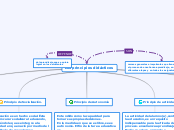GESTIÓN PARA EL APRENDIZAJE
Type in the name of the book you have read.
SEMANA 4
EL APRENDIZAJE
The main idea is what the book is mostly about.
Some tips to find out the main idea of a book easier:
- Read the title.
- Look for the text features.
- Figure out if you are reading a fiction or a non fiction book.
- Think about some examples that support this idea.
ESTILOS DE APRENDIZAJE
MODELOS DE ESTILOS DE APRENDIZAJE
APRENDIZAJE EXPERIENCIAL
KOLB
ACOMODADOR
CONVERGENTE
ASIMILADOR
DIVERGENTE
MODELO PNL - VAK
DE
GRINDER
BLANDER
KINESTESICO
AUDITIVO
VISUAL
SEMANA 3
Type the names of the book characters. Start with the main character.
Draw arrows to represent the relationship between them and if it is possible write on them what they represent for each other (if they are relatives, friends, lovers, enemies etc.)
PROYECTO PERSONAL DE APRENDIZAJE
Un proyecto personal de aprendizaje le da un por que y un para que a la existencia humana, finalizando con fases importantes en la vida.
FODAS
Oportunidades (externas)
Amenazas
Debilidades
Fortalezas (internas)
Es aquello que una persona traza con el fin de conseguir uno o varios propósitos para su existencia.
What are the characteristics that best describe the character? Type them here.
PASOS PARA ELABORAR EL PROYECTO PERSONAL
Misión personal
Metas estratégicas
Visión personal
Diagnostico personal
SEMANA 2
What is the reason why the author wrote the book?
INTELIGENCIAS MULTIPLES
Intrapersonal
Relacionada con el gusto por los juegos individuales, soñar e imaginar, pensar, reflexionar, entre otros.
Naturalista
Relacionada por el gusto de realizar cosas al aire libre, es decir al ambiente natural.
Lingüística Verbal
Sensibilidad a los sonidos, la estructura, los significados y las funciones de la palabras y el lenguaje.
corporal-Kinestésico
Relacionada por el gusto de querer realizar las cosas con movimiento.
Interpersonal
Capacidad para discernir y responder adecuadamente a los estados de ánimos, temperamento, motivaciones y deseos de otros.
Musical
Habilidad para producir y apreciar el ritmo, tono, timbre.
Lógico Matemática
Capacidad para discernir los esquemas numéricos o lógicos.
Visual-Espacial
Percibir el mundo Visual y espacial, efectuando trasformaciones.
HABILIDADES DE PERSONAS EFECTIVAS
No procrastinan
Resiliencia
Vocabulario adecuado
Relaciones interpersonal sanas
Buena imagen
Objetivos y plan de vida claros
Administración del Tiempo
Persistencia
Autoestima sana
AUTOEFICACIA
Es la creencia de una persona en su capacidad de tener éxito en una situación particular
SEMANA 1
Who is the author of the book? Type in his/her name.
AUTOCONCEPTO
Es la imagen que hemos creado sobre nosotros mismos, un conjunto de ideas que creemos que nos definen.
INTEGRANTES
ANDREA IMEY BACA FLOREZ
JAMIL ALFREDO AUCCAPINA SANTA CRUZ
LUZMY HUAMAN MOSCOSO
BRIYITE CACERES cruz
JUDITH ESTHER APAZA MAMANI
SEMANA 5
Type the main events of the book, classifying them in: events from the beginning, events from the middle, and events from the end of the book.
Describe the story visually. Add a representative picture for each of them.
PLE(Entorno Personal de Aprendizaje)
DIFERENCIA ENTRE PLE Y PLN
PLN
Unión de varios entonos de aprendizaje
Estar redistribuido
Pasivo
Múltiple
Es colectivo
PLE
Puede estar centralizado o distribuido
Consciente
Dinámico
único
Personal
LA WEB 2.0 Y SU IMPORTANCIA EN EL PLE
Posibilito la generación de entornos personales de aprendizaje(PLE). donde el estudiante contruye su ambiente de aprendizajes mediante herramientas con las que se está familiarizando.
(COMPARTIR) Personal Learning Network (PLN)
(ORGANIZAR, REFLEXIONAR Y CREAR ) creación de información
(ADQUIRIR) acceso a la información
FUNCIONES DEL PLE
Colaborar con otros en tareas de producción colectivo
Publicarlos para compartirlos con la comunidad
Crear nuevos contenidos
Comunicarse con los demás
Organizar los contenidos
Buscar y filtrar la información de interes
Conjunto de herramientas gratuitas, recursos, fuentes de información y contactos que cada persona usa para aprender.
Type the main events from the beginning.
Add a representative picture for each of them.
SEMANA 6
SOCIAL LEARNING ENVIRONMENT (AMBIENTE DE APRENDIZAJE SOCIAL)
PARTES
LECTORES O AGREGADORES RSS
PODCASTING
HERRAMIENTAS DE COMUNICACION
COMPARTIR ARCHIVOS
MARCADORES SOCIALES
ETIQUETADO DE CONTENIDO
REDES SOCIALES
NO
NO SIGUE A SUS USUARIOS
NO CONTROLA
NO GESTIONA
TERMINOS EN CUENTA
EDUCACION INFORMAL
EDUCACION NO FORMAL
EDUCACION FORMAL
ES
UTILIZADO PARA EXTENDER CONTENIDO Y HACERLO ENTENDIBLE
UN LUGAR DONDE LAS PERSONAS COMPARTEN Y CREAN
UNA REFERENCIA A LA RED SOCIAL
SEMANA 7
TRABAJO COLABORATIVO
Take notes while you read the book. Write here your favorite quotes from the book.
Estrategia de enseñanza en la que se organizan pequeños grupos de trabajo establecidos previamente donde se comparte información por diferentes medios
HERMIENTAS VISTUALES PARA EL TRABAJO COLABORATIVO
COMUNICAR, DEBATIR Y COLABORAR
Skype
Patley
ALMACENAR Y COMPARTIR ARCHIVOS
One drive
Google drive
ENTORNO DE TRABAJO
Autlook
Office 365
ORGANIZA EL TRABAJO
Google calendar
Evernote
TRABAJO COLABORATIVO EN REDES
Trabajo Colaborativo consiste en aprender con otros y de otros este término hace referencia a un grupo de personas que trabajan pero compartiendo un espacio real o virtual
ESTRATEGIAS DE TRABAJO COLABORATIVO EN REDES
Responsabilidades individuales y compartidas
Relación de interdependencia de los grupos
RELACIONES SIMÉTRICAS Y RECÍPROCAS
DIFERENCIA ENTRE TRABAJO EN GRUPO Y TRABAJO COLABORATIVO
Producir conocimiento
Compartido
TRABAJO EN GRUPO
Individual
Completar la tarea
Uno solo
CARACTERISTICAS
Liderazgo
Responsabilidad
Objetivo final









